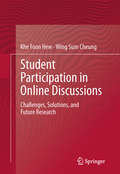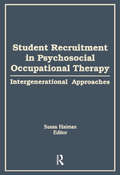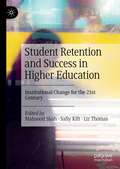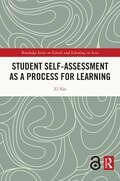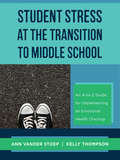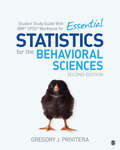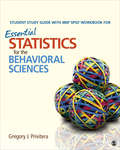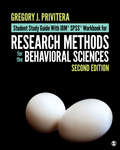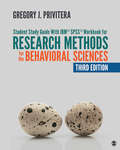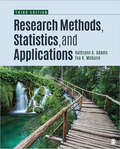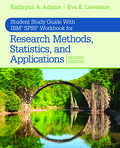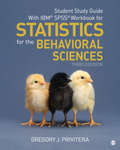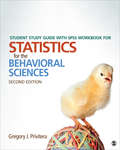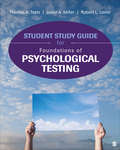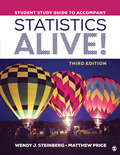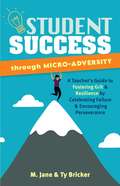- Table View
- List View
Student Participation in Online Discussions
by Khe Foon Hew Wing Sum CheungThe increasingly prevalent use of online- or blended-learning in schools universities has resulted in asynchronous online discussion forum becoming an increasingly common means to facilitate dialogue between instructors and students, as well as students and students beyond the boundaries of their physical classrooms. This proposed academic book contributes to the literature on asynchronous online discussions in the following three main ways: First, it reviews previous research studies in order to identify the factors leading to limited student contribution. Limited student contribution is defined as students making few or no postings, students exhibiting surface-level thinking or students demonstrating low-level knowledge construction in online discussions. It then identifies the various empirically-based guidelines to address the factors. Second, three potential guideline dilemmas that educators may encounter: (a) use of grades, (b) use of number of posting guideline, and (c) instructor-facilitation are introduced. These are guidelines where previous empirical research shows mixed results when they are implemented. Acknowledging the dilemmas is essential for educators and researchers to make informed decisions about the discussion guidelines they are considering implementing. Third, nine exploratory case studies related to student-facilitation and audio-based discussion are reported on and examined. Using students as facilitators may be an alternative solution to educators who wish to avoid the instructor-facilitation guideline dilemma. Using audio discussion would be useful for participants with poor typing skills or those who prefer talking to typing. The proposed book is distinctive in comparison to current competitor titles because all the findings and guidelines are empirically-based. Furthermore, the nine expanded case studies provided specifically address the issue of student/peer facilitation and audio-based discussion. Student/peer facilitation and audio discussion are two areas that hitherto received comparatively lesser attention compared to instructor facilitation and text-based discussion.
Student Recruitment in Psychosocial Occupational Therapy: Intergenerational Approaches
by Diane Gibson Susan HaimanThis volume addresses the problems the OT profession faces recruiting students into mental health as a practice specialty. The content reflects several efforts at engaging students in the exploration of the variety of available career paths in this area. Educators, supervisors, clinicians, and students facing career choices will be able to take a unique perspective on specialty selection after reviewing the thoughts, perspectives, theories, and philosophies of some of occupational therapy’s foremost leaders in mental health. In addition, readers will get an “up close” opportunity to review one institution’s efforts to educate and recruit level II fieldwork students through an all-day program designed to expose them to the widest possible range of practice opportunities.
Student Retention and Success in Higher Education: Institutional Change for the 21st Century
by Mahsood Shah Liz Thomas Sally KiftThis book draws together international research to assess the quality of successful efforts to retain students. The editors and contributors unite diverse global research from countries who have led student retention and success projects at national, institutional, faculty or program level with positive outcomes. The book is underpinned by the philosophy that a more diverse student population requires higher education institutions to fundamentally change, in order to facilitate the success of all students. All of humanity, its economies and societies, are being pummelled by waves of pandemic-induced crises in tandem with globalisation and demographic shifts. Ultimately, this book acts as a clarion to higher education institutions to better support and retain their students, in order to create a more stable learning environment.
Student Self-Assessment as a Process for Learning (Routledge Series on Schools and Schooling in Asia)
by Zi YanCovering both higher education and school education, this book contributes to the field of assessment by providing a systematic account of student self-assessment based on a consistent conceptualisation. Yan advocates viewing self-assessment as an active and reflective process and using it as a learning strategy rather than an assessment method. He builds on a newly-developed self-assessment model adopting a process perspective and synthesises a series of interrelated empirical investigations into the whole "chain" of student self-assessment research. The research encompassed in the volume spans from self-assessment practices and measurement, through predictors of self-assessment, its interweaved relationship with self-regulated learning and feedback literacy, impact on student learning outcomes, to designing sustainable self-assessment interventions. The empirical evidence is from a wide range of current scholarship to ensure that the principles and implications conveyed are applicable internationally. Policymakers, students and scholars in educational assessment, educational psychology, and teaching and instruction will find the theoretical explorations and empirical investigations contained within useful, to show how student self-assessment could be better conceptualised, researched, and practised.
Student Stress at the Transition to Middle School: An A-to-Z Guide for Implementing an Emotional Health Check-up
by Ann Vander Stoep Kelly ThompsonResources, checklists, instructions, and training materials for assessing student well-being. The transition to middle school is often fraught with emotional, social, and academic challenges for students. Often, teachers don't have the proper resources to identify students for whom this transition is becoming a problem. In this book, Ann Vander Stoep and Kelly Thompson provide teachers, counselors, and administrators with a complete package for implementing the "Emotional Health Checkup": a program designed to identify and help middle school students who are in need of additional emotional support. Readers will learn how to detect if a student's stress has shifted from a manageable level to an unhealthy "distress" level. They will then learn how to decide if the Emotional Health Checkup is a good fit for their school and how to get the school on board to implement the program. The book is an A-to-Z guide on how to implement the Emotional Health Checkup once the need and commitment have been confirmed. Information includes: how to engage parents and guardians in the process, carry out the logistics of classroom screening day, and develop individualized student support plans. Complete orientation and training manuals are provided.
Student Study Guide With IBM® SPSS® Workbook for Essential Statistics for the Behavioral Sciences
by Dr Gregory J. PriviteraGregory J. Privitera’s Student Study Guide With IBM® SPSS® Workbook for Essential Statistics for the Behavioral Sciences, Second Edition includes a review of chapter learning objectives, chapter outlines and key terms, essential statistical formulas, special tips and insights for students, and chapter summaries. To help students practice skills, the guide offers word searches and crossword puzzles for each chapter, extensive practice quizzes linked to chapter learning objectives, and “SPSS in Focus” exercises which complement those in Privitera’s core text, Essential Statistics for the Behavioral Sciences, Second Edition.
Student Study Guide With IBM® SPSS® Workbook for Essential Statistics for the Behavioral Sciences
by Dr Gregory J. PriviteraGregory J. Privitera’s Student Study Guide With IBM® SPSS® Workbook for Essential Statistics for the Behavioral Sciences, Second Edition includes a review of chapter learning objectives, chapter outlines and key terms, essential statistical formulas, special tips and insights for students, and chapter summaries. To help students practice skills, the guide offers word searches and crossword puzzles for each chapter, extensive practice quizzes linked to chapter learning objectives, and “SPSS in Focus” exercises which complement those in Privitera’s core text, Essential Statistics for the Behavioral Sciences, Second Edition.
Student Study Guide With IBM® SPSS® Workbook for Essential Statistics for the Behavioral Sciences: Privitera: Essential Statistics For The Behavioral Sciences + Privitera: Student Study Guide With Ibm® Spss® Workbook For Essential Statistics For The Behavioral Sciences
by Dr Gregory J. PriviteraThe Student Study Guide With IBM® SPSS® Workbook for Essential Statistics for the Behavioral Sciences, by Gregory J. Privitera, includes a review of chapter learning objectives, chapter outlines and key terms, essential statistical formulas, special tips and insights for students, and chapter summaries. To help students practice skills, the guide offers word searches and crossword puzzles for each chapter, extensive practice quizzes linked to chapter learning objectives, and “SPSS in Focus” exercises which complement those in the book.
Student Study Guide With IBM® SPSS® Workbook for Essential Statistics for the Behavioral Sciences: Privitera: Essential Statistics For The Behavioral Sciences + Privitera: Student Study Guide With Ibm® Spss® Workbook For Essential Statistics For The Behavioral Sciences
by Dr Gregory J. PriviteraThe Student Study Guide With IBM® SPSS® Workbook for Essential Statistics for the Behavioral Sciences, by Gregory J. Privitera, includes a review of chapter learning objectives, chapter outlines and key terms, essential statistical formulas, special tips and insights for students, and chapter summaries. To help students practice skills, the guide offers word searches and crossword puzzles for each chapter, extensive practice quizzes linked to chapter learning objectives, and “SPSS in Focus” exercises which complement those in the book.
Student Study Guide With IBM® SPSS® Workbook for Research Methods for the Behavioral Sciences
by Dr Gregory J. PriviteraThe Student Study Guide With IBM® SPSS® Workbook for the award-winning Research Methods for the Behavioral Sciences, Second Edition by Gregory J. Privitera includes a review of chapter learning objectives, chapter outlines and key terms, essential statistical formulas, special tips and insights for students, and chapter summaries. To help students practice their skills, the guide offers additional exercises, extensive practice quizzes linked to chapter learning objectives and SPSS in Focus exercises which complement those in the main text.
Student Study Guide With IBM® SPSS® Workbook for Research Methods for the Behavioral Sciences
by Dr Gregory J. PriviteraThe Student Study Guide With IBM® SPSS® Workbook for the award-winning Research Methods for the Behavioral Sciences, Second Edition by Gregory J. Privitera includes a review of chapter learning objectives, chapter outlines and key terms, essential statistical formulas, special tips and insights for students, and chapter summaries. To help students practice their skills, the guide offers additional exercises, extensive practice quizzes linked to chapter learning objectives and SPSS in Focus exercises which complement those in the main text.
Student Study Guide With IBM® SPSS® Workbook for Research Methods for the Behavioral Sciences: Privitera: Research Methods For The Behavioral Sciences 2e + Student Study Guide With Ibm® Spss® Workbook For Research Methods For The Behavioral Sciences 2e
by Dr Gregory J. PriviteraThe Student Study Guide With IBM® SPSS® Workbook for Research Methods for the Behavioral Sciences, Third Edition by Gregory J. Privitera includes a review of chapter learning objectives, chapter summaries, and tips and cautions. To help students practice their skills, the guide offers quizzes and exercises accompanied by answers keys; SPSS in Focus exercises with general instructions complement those in Privitera’s main text, Research Methods for the Behavioral Sciences, Third Edition.
Student Study Guide With IBM® SPSS® Workbook for Research Methods for the Behavioral Sciences: Privitera: Research Methods For The Behavioral Sciences 2e + Student Study Guide With Ibm® Spss® Workbook For Research Methods For The Behavioral Sciences 2e
by Dr Gregory J. PriviteraThe Student Study Guide With IBM® SPSS® Workbook for Research Methods for the Behavioral Sciences, Third Edition by Gregory J. Privitera includes a review of chapter learning objectives, chapter summaries, and tips and cautions. To help students practice their skills, the guide offers quizzes and exercises accompanied by answers keys; SPSS in Focus exercises with general instructions complement those in Privitera’s main text, Research Methods for the Behavioral Sciences, Third Edition.
Student Study Guide With IBM® SPSS® Workbook for Research Methods, Statistics, and Applications
by Kathrynn A. Adams Eva Kung McGuire (aka: Lawrence)The third edition of the Student Study Guide With IBM® SPSS® Workbook for Research Methods, Statistics, and Applications by Kathrynn A. Adams and Eva K. McGuire gives students even more opportunities to practice and apply their knowledge in statistics and research methods. Written by the authors of Research Methods, Statistics, and Applications, the third edition of the study guide follows the third edition of the textbook for straightforward assigning and practice. New features include practice quizzes to give students both recognition and recall activities for better retention. Learning objectives and brief chapter summaries from the main text remind students of what they′ve learned and orient students toward the exercises. In-depth exercises encourage students to build on their knowledge, requiring students to think critically and actively engage with the material. These exercises have been condensed and focus on moving students through the learning objectives at a quick pace. At the end of most chapters, "Your Research" sections encourage students to apply concepts to their own projects. Now placed at the end of book, the IBM® SPSS® workbook provides instructions for performing statistical calculations. Included in this workbook are additional exercises to practice data analysis and interpretation using the software. Answers to quizzes are listed immediately after each quiz in the book while answers to exercises are listed on the instructor resources website.
Student Study Guide With IBM® SPSS® Workbook for Research Methods, Statistics, and Applications
by Kathrynn A. Adams Eva Kung McGuire (aka: Lawrence)The third edition of the Student Study Guide With IBM® SPSS® Workbook for Research Methods, Statistics, and Applications by Kathrynn A. Adams and Eva K. McGuire gives students even more opportunities to practice and apply their knowledge in statistics and research methods. Written by the authors of Research Methods, Statistics, and Applications, the third edition of the study guide follows the third edition of the textbook for straightforward assigning and practice. New features include practice quizzes to give students both recognition and recall activities for better retention. Learning objectives and brief chapter summaries from the main text remind students of what they′ve learned and orient students toward the exercises. In-depth exercises encourage students to build on their knowledge, requiring students to think critically and actively engage with the material. These exercises have been condensed and focus on moving students through the learning objectives at a quick pace. At the end of most chapters, "Your Research" sections encourage students to apply concepts to their own projects. Now placed at the end of book, the IBM® SPSS® workbook provides instructions for performing statistical calculations. Included in this workbook are additional exercises to practice data analysis and interpretation using the software. Answers to quizzes are listed immediately after each quiz in the book while answers to exercises are listed on the instructor resources website.
Student Study Guide With IBM® SPSS® Workbook for Research Methods, Statistics, and Applications 2e
by Kathrynn A. Adams Eva K. LawrenceDo you want more practice with research methods and statistics outside of class? Then the Student Study Guide With IBM® SPSS® Workbook for Research Methods, Statistics, and Applications, Second Edition, is for you. Written by Kathrynn A. Adams and Eva K. Lawrence, this study guide accompanies the new second edition of Research Methods, Statistics, and Applications and provides instructions for performing statistical calculations in IBM® SPSS® along with additional exercises to reinforce concepts in the text. It follows the main text chapter by chapter to provide for easy assigning and studying. Step-by-step directions for IBM® SPSS® Data Analysis and Interpretation are included with practice exercises to facilitate competence in using the program as well as interpreting and writing up results. Answers to odd-numbered questions are provided so students can obtain quick feedback. The Your Research section helps readers develop their own research topics. Learning outcomes tied to relevant chapters in the text reinforce key concepts for review.
Student Study Guide With IBM® SPSS® Workbook for Research Methods, Statistics, and Applications 2e
by Kathrynn A. Adams Eva K. LawrenceDo you want more practice with research methods and statistics outside of class? Then the Student Study Guide With IBM® SPSS® Workbook for Research Methods, Statistics, and Applications, Second Edition, is for you. Written by Kathrynn A. Adams and Eva K. Lawrence, this study guide accompanies the new second edition of Research Methods, Statistics, and Applications and provides instructions for performing statistical calculations in IBM® SPSS® along with additional exercises to reinforce concepts in the text. It follows the main text chapter by chapter to provide for easy assigning and studying. Step-by-step directions for IBM® SPSS® Data Analysis and Interpretation are included with practice exercises to facilitate competence in using the program as well as interpreting and writing up results. Answers to odd-numbered questions are provided so students can obtain quick feedback. The Your Research section helps readers develop their own research topics. Learning outcomes tied to relevant chapters in the text reinforce key concepts for review.
Student Study Guide With IBM® SPSS® Workbook for Statistics for the Behavioral Sciences
by Dr Gregory J. PriviteraThe Student Study Guide With IBM® SPSS® Workbook for Statistics for the Behavioral Sciences, Third Edition includes a review of chapter learning objectives, chapter outlines and key terms, essential statistical formulas, special tips and insights for students, and chapter summaries. To help students practice skills, the guide offers word searches and crossword puzzles for each chapter, extensive practice quizzes linked to chapter learning objectives, and “SPSS in Focus” exercises which complement those in the core text.
Student Study Guide With IBM® SPSS® Workbook for Statistics for the Behavioral Sciences
by Dr Gregory J. PriviteraThe Student Study Guide With IBM® SPSS® Workbook for Statistics for the Behavioral Sciences, Third Edition includes a review of chapter learning objectives, chapter outlines and key terms, essential statistical formulas, special tips and insights for students, and chapter summaries. To help students practice skills, the guide offers word searches and crossword puzzles for each chapter, extensive practice quizzes linked to chapter learning objectives, and “SPSS in Focus” exercises which complement those in the core text.
Student Study Guide With SPSS Workbook for Statistics for the Behavioral Sciences
by Dr Gregory J. PriviteraThe Student Study Guide With SPSS Workbook for Statistics for the Behavioral Sciences, Second Edition, by Gregory J. Privitera, includes a review of chapter learning objectives, chapter outlines and key terms, essential statistical formulas, special tips and insights for students, and chapter summaries. To help students practice skills, the guide offers word searches and crossword puzzles for each chapter, extensive practice quizzes linked to chapter learning objectives, and “SPSS in Focus” exercises which complement those in the book.
Student Study Guide for Foundations of Psychological Testing
by Leslie A. Miller Robert L. Lovler Thomas A. StetzThe Student Study Guide for Foundations of Psychological Testing has 15 chapters corresponding to those in the main textbook and follows a consistent structure for quick and easy access to key information. To help students understand and apply material related to psychological testing, authors Thomas A. Stetz, Leslie A. Miller, and Robert L. Lovler offer overviews, learning objectives, outlines, key concepts, crossword puzzles, tips by learning objective, additional exercises, additional learning activities, practice questions, and answer keys.
Student Study Guide for Foundations of Psychological Testing
by Leslie A. Miller Robert L. Lovler Thomas A. StetzThe Student Study Guide for Foundations of Psychological Testing has 15 chapters corresponding to those in the main textbook and follows a consistent structure for quick and easy access to key information. To help students understand and apply material related to psychological testing, authors Thomas A. Stetz, Leslie A. Miller, and Robert L. Lovler offer overviews, learning objectives, outlines, key concepts, crossword puzzles, tips by learning objective, additional exercises, additional learning activities, practice questions, and answer keys.
Student Study Guide to Accompany Statistics Alive!
by Matthew Price Wendy J. Steinberg Zoe BrierThis affordable student study guide and workbook to accompany Wendy J. Steinberg and Matthew Price&’s Statistics Alive!, Third Edition helps students get the added review and practice they need to improve their skills and master their Introduction to Statistics course.
Student Study Guide to Accompany Statistics Alive!
by Matthew Price Wendy J. Steinberg Zoe BrierThis affordable student study guide and workbook to accompany Wendy J. Steinberg and Matthew Price&’s Statistics Alive!, Third Edition helps students get the added review and practice they need to improve their skills and master their Introduction to Statistics course.
Student Success Through Micro-Adversity: A Teacher's Guide to Fostering Grit and Resilience by Celebrating Failure and Encouraging Perseverance (Books For Teachers Ser.)
by M. Jane Ty BrickerCultivate resilience by incorporating small challenges (also known as micro-adversities) in your classroom with effective, trauma-informed strategies that are proven to improve behavior, increase engagement, and empower students to achieve.One in four children have witnessed or experienced a traumatic event by the age of 16 that can affect behavior and learning. Fortunately, educators of all grade levels can inspire resilience and grit that helps students adapt to change and overcome hardship with simple everyday activities. This book offers a breakthrough method for building community and empowering your students with a new strategy: micro-adversity. Micro-adversities in the classroom can be actionable activities, like trying to solve a puzzle that is intentionally missing a few pieces, or building emotional intelligence with conversation starters. By experiencing small failures, students learn to overcome them and thrive. Written by two teachers, one a former US Army Ranger, this method combines the extensively trained military perspective with the important foundations of trauma-informed education.
